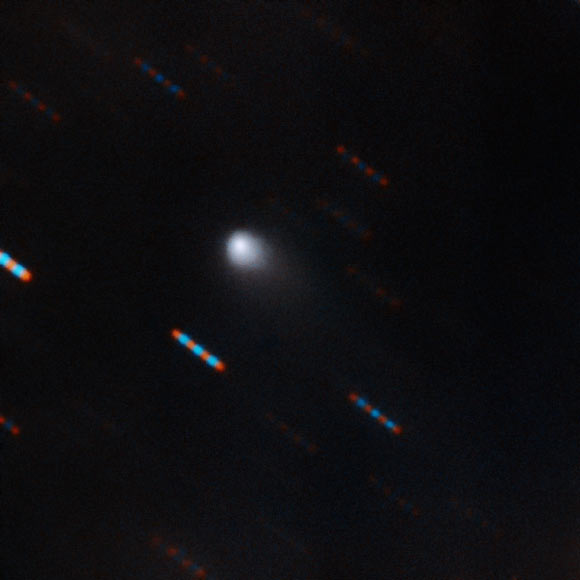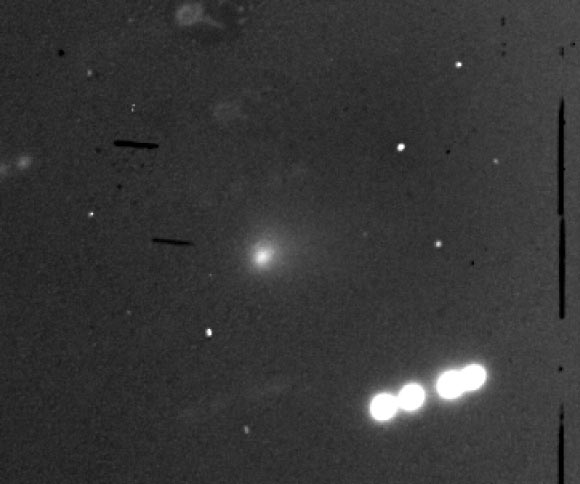Astronomers Observe Interstellar Comet C/2019 Q4 | Astronomy – Sci-News.com
Using several ground-based telescopes on La Palma and Hawaii, astronomers have observed C/2019 Q4, the first-known interstellar comet and the second-known interstellar object identified in the Solar System.

This composite image, obtained by the Gemini North Multi-Object Spectrograph on the 8.2-m Gemini North telescope, shows the interstellar comet C/2019 Q4. Image credit: Gemini Observatory / NSF / AURA / Travis Rector.
C/2019 Q4 was first detected on August 30, 2019 by Gennady Borisov, an astronomer at the Crimean Astrophysical Observatory in Nauchnij, Ukraine.
On September 10, Dr. Piotr Guzik of the Jagiellonian University’s Astronomical Observatory and his colleagues from Poland and the Netherlands observed the comet using the 4.2-m William Herschel Telescope on La Palma and the 8.2-m Gemini North telescope on Hawaii’s Maunakea.
At the time of the observations, the object was about 257 million miles (413 million km) from the Sun and 318 million miles (512 million km) from Earth.
The images reveal an active comet that is between 1.2 and 10 miles (2-16 km) across.
They also show an extended coma and a broad, short tail emanating in roughly antisolar direction — the canonical signatures of cometary activity.
“The extended coma and broad tail displayed by the object stand in stark contrast with the purely asteroidal appearance of ‘Oumuamua,” Dr. Guzik and co-authors said in their paper on arXiv.org.
“Both orbital and morphological properties of this body show that this is the first certain case of an interstellar comet, and the second-known interstellar minor body identified in the Solar System.”
Another team of astronomers, led by Dr. Julia de Leon of the Instituto de Astrofisica de Canarias, observed C/2019 Q4 on the night of September 12, 2019, using the 10.4-m Gran Telescopio Canarias.
“The spectrum of this object is similar to those of solar system comets and this indicates that their composition must be similar,” Dr. de Leon said.
C/2019 Q4 entered the Solar System from interstellar space at 76,000 mph (33.8 km/s) in the constellation of Cassiopeia, close to the open star cluster Stock 2.
The comet is heading toward the inner Solar System and is currently 260 million miles (420 million km) from the Sun.
On October 26, 2019, it will pass through the ecliptic plane from above at roughly a 40-degree angle.
It is expected to make its closest approach to the Sun on December 9, coming within about 182 million miles (293 million km) of our star, and will reach its closest point to Earth on December 28 at a distance of about 176 million miles (283 million km).
“C/2019 Q4 is destined for an unprecedented observing campaign lasting many months that will allow us to gain sensational insights into the physical properties of interstellar comets and extrasolar planetary systems in general,” Dr. Guzik and colleagues said.
“The discovery of this object indicates that interstellar comets might be common and creates a tremendous opportunity to study the first such object in detail.”
_____
Piotr Guzik et al. 2019. Interstellar Comet 2I/Borisov. arXiv: 1909.05851
Julia de Leon et al. 2019. Interstellar Visitors: A Physical Characterization of Comet C/2019 Q4 (Borisov) with OSIRIS at the 10.4 m GTC. AAS20106






